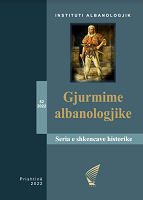NDIKIMET NGA MESDHEU NË DARDANINË PARAROMAKE DHE ROMAKE
THE MEDITERRANEAN INFLUENCES IN PREROMAN AND ROMAN DARDANIA
Author(s): Naser FerriSubject(s): Archaeology, Cultural history, Social history, Ancient World
Published by: Instituti Albanologjik i Prishtinës
Keywords: Dardania; Adriatic Sea; Greece; Rome; East civilizations; Mediterranean;
Summary/Abstract: The Dardanians and their state (northern part of present-day Northern Macedonia, all of Kosovo and large part of Serbia all the way to the West Morava river) at the crossroads connecting northern Europe and the southern Balkans and Greece, and the interior of the Balkans and the Illyrian coast, began to be mentioned the same from IVo century BC in the works of Roman writers Polyenus, Justinus and Pompey Trogus, when the Dardanian kings offered the Macedonian king the help of 20,000 Dardanian soldiers to fight the Celtic attacks, and because of military alliances with the Romans in the wars against Macedonia, as seen in the works of Titus Livius and Polybius, but archeological finds in Banjë e Pejë testify that already in the VIo century BC the Dardanians had an organized society led by princes, that in the Vo century BC they minted their money in Damastion, but that Influences of cultures of different peoples from the Mediterranean were confirmed in pre-Roman times, and are manifested primarily in the findings of ceramic pottery, jewelry and war equipment imported from the Mediterranean and the findings of so-called "Illyrian drachmas" minted in Illyrian mints ( Apollonia and Dyrrahium) in the Adriatic, which during the IIo and Io centuries BC were considered the universal currency throughout the Balkans and wider. After the Roman conquest of the Dardanian Kingdom and the creation of the province of Moesia, ie in 86, Upper Moesia, which included the Dardanian territory, these influences across Rome and the Adriatic coast became more frequent with the arrival of Roman legions: Legio VII Claudia and Legio IV Flavia from Dalmatia. in the findings of epigraphic monuments of legionaries who were partly of Dalmatian origin and some of them served in the Roman imperial river fleet (Classis Flavia Moesica), as evidenced by the epigraphic monument found in Naissus which mentions the disce(n)s epibeta (from the Greek epibates). Epigraphic monuments confirm that the Romans and those who came with them to Dardania brought with them Latin, Latin and Greek-Oriental onomastics and the worship of Roman water deities: the Roman god Neptunus in the interior of Dardania along the barren rivers: Ibër, Sitnicë, Lushtë, and the Drini i Bardhë, and the worship of the cult of the Syrian goddess Atargatis along the Vardar and Treska rivers. With the Romans and their companions in the Dardanian territory from the Mediterranean through Greece, Rome and the Adriatic came the worship of some deities of Greek-Oriental provenance: Aesculapius-Asclepius, Hygia, Telesphorus, Nemesis, Isis, Serapis, Atargatis, Dolichenus, Mithra and even cult the deified mortal Antinous, a favorite and probably lover of Emperor Hadrian, who drowned in the Nile and to whom Hadrian built temples throughout the Empire and thus in the Dardanian Municipium DD. Christianity also arrived in the Dardanian territory via the Mediterranean, but based on archeological findings a little later than in the coastal parts of Illyricum where it was brought by St. Paul, to be archeologically confirmed during the time of Emperor Constantine in the area of the municipium in Peja, and already at the Council of Nicea in 325, among the other bishops of Illyricum, one Dardanian bishop (Bishop Dacus of Scupi), was mentioned for the first time which speaks in favor of the fact that Christianity already had an institutional system and hierarchy in Dardania which belonged to the Dacian diocese. The mentioned Mediterranean influences are archaeologically confirmed in the area inhabited by the Dardanians, and chronologically can be classified between the VIo century BC and the time of the Dardanian Kingdom, over the period when the Romans conquered it militarily in the Io century AD and made it part of the Roman Empire until the IVo century.
Journal: Gjurmime Albanologjike - Seria e shkencave historike
- Issue Year: 2022
- Issue No: 52
- Page Range: 11-42
- Page Count: 32
- Language: Albanian
- Content File-PDF

